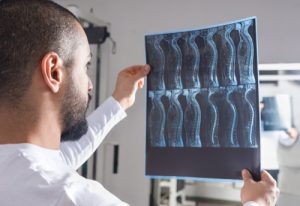SMA News for HCPs: Stasimon, nusinersen in adult patients, managing collapsing spine deformity & more

Understanding SMA
Stasimon contributes to the loss of sensory synapses and motor neuron death in a mouse model of spinal muscular atrophy.1
In this paper, the authors elucidate a mechanism of the motor neuron degeneration that occurs in SMA. Specifically, the authors found that dysfunction of Stasimon, a protein of the endoplasmic reticulum that is regulated by SMN, leads to motor neuron degeneration and synaptic loss. When Stasimon was delivered via an adeno-associated virus serotype 9 (AAV9), motor function was improved in a mouse model of SMA.
Read more here.
Recent Review:
- The effects of statins on microglial cells to protect against neurodegenerative disorders: A mechanistic review.2
This review covers data on the application of statins to minimize neuroinflammation by regulating microglia activation. SMA and other neurodegenerative diseases appear to arise from uncontrolled neuroinflammation that occurs when microgliosis is not well controlled. Though conventionally used as a preventative measure for those at risk for cardiovascular and coronary heart diseases, the authors argue that there is now evidence to suggest that statins may also help to prevent neurodegenerative diseases.
Read more here.
Treating SMA
Spinal muscular atrophy – expert recommendations for the the use of nusinersen in adult patients.3
This piece covers a discussion on the documentation of the use of nusinersen in SMA patients in Germany that took place at a recent conference in Frankfurt. It highlights the value of systematically collected and stored data for optimizing treatment paradigms.
Read more here.
Spinal muscular atrophy modeling and treatment advances by induced pluripotent stem cell studies.4
In this piece, the authors point to the limitations of current animal models for studying SMA – particularly the relevant regulatory mechanisms. They argue that to circumvent these weaknesses, studies should employ patient-derived stem cells. Specifically, they discuss the potential value of induced pluripotent stem cells (iPSCs) for the study of SMA pathology as well as the possibility that these stem cells could play a therapeutic role in the disease.
Read more here.
Alternative splicing and the cure of spinal muscular atrophy.5
This piece discusses the role of alternative splicing in synthetic oligonucleotide therapy for SMA and how Spinraza effectively treats the disease by correcting abnormal alternative splicing in the SMN2 gene.
Read more here.
Recent Review:
- Adeno-associated viral vector-mediated immune responses: Understanding barriers to gene delivery.6
Given that adeno-associated viral (AAV) vectors have become the go-to platform for gene therapy in SMA and other diseases, there are ongoing efforts to understand and optimize AAV tools. In this review, the authors cover our relevant knowledge to date and discuss how immune responses to AAV vectors can be manipulated to enhance gene transfer.
Read more here.
 SMA Management
SMA Management
Early results of a management algorithm for collapsing spine deformity in young children (below 10-year old) with spinal muscular atrophy type II.7
SMA patients often develop scoliosis, which can require several surgeries. To reduce the risk of pulmonary complications, it is important to minimize the number of surgeries that these patients undergo. This paper covers a study into the value of magnetically controlled growing rods (MCGR) in collapsing spine deformity occurring in SMA patients. According to the author’s observations, MCGR may reduce the number of required procedures to treat this condition in SMA patients. In the case of curve rigidity, the authors specifically recommend apical deformity control in the convex side. The authors also point to the need to include the pelvis in instrumentation to prevent distal adding-on.
Read more here.
Patient Focus and Policy Implications
Cognitive performance of children with spinal muscular atrophy: A systematic review.8
This systematic review investigated the link between SMA and cognitive impairment. Though the data from several studies have suggested that cognition in SMA patients is comparable to that of their healthy peers, there is also evidence to suggest that motor impairment severity may be related to cognitive outcomes, as studies that included a higher proportion of SMA type I patients found cognitive impairment in those with SMA. The authors suggest that more research is needed to identify potential differences in cognitive outcomes in patients with different types of SMA.
Read more here.
False negative carrier screening in spinal muscular atrophy.9
This paper describes a case of a false negative screen for SMA. The authors point out that it is important for clinicians to perform diagnostic tests on children whose clinical appearance is consistent with SMA, even if a negative test result was produced during parental carrier testing.
Read more here.
Enhanced carrier screening for spinal muscular atrophy: Detection of silent (SMN1: 2 + 0) carriers utilizing a novel TaqMan genotyping method.10
Screening for SMA tends to focus on SMN1 copy number. However, copy arrangement also affects SMA risk. Specifically, those with SMN1 genes located on the same chromosome are considered silent carriers of the disease. This paper describes a new method for identifying these types of SMA silent carriers in a quick and cost-effective way. According to the data from this pilot, the results of this new screening procedure are also highly accurate and can improve SMA detection.
Read more here.
A new case of SMABF2 diagnosed in stillbirth expands the prenatal presentation and mutational spectrum of ASCC1.11
In this paper, the authors describe the first case of a stillbirth involving a fetus with SMA with congenital bone fractures 2 (SMABF2) where the disease evolution was documented prenatally. According to the authors, this case broadens the mutational spectrum of the ASCC1 gene, as in this case, an exonic microdeletion and a nucleotide variant led to ASCC1 compound heterozygosity.
Read more here.
244th ENMC international workshop: Newborn screening in spinal muscular atrophy May 10-12, 2019, Hoofdorp, The Netherlands.12
This piece describes a 2019 SMA workshop that convened SMA patients and experts to discuss newborn screening for the disease. The aim of the workshop was to identify knowledge gaps concerning patient responses to newborn screening. Ethical considerations as well as the need for screening guidelines and recommendations were addressed.
Read more here.
References
1. Simon CM, Van Alstyne M, Lotti F, et al. Stasimon Contributes to the Loss of Sensory Synapses and Motor Neuron Death in a Mouse Model of Spinal Muscular Atrophy. Cell Rep. 2019;29(12):3885-3901.e5. doi:10.1016/j.celrep.2019.11.058
2. Bagheri H, Ghasemi F, Barreto GE, Sathyapalan T, Jamialahmadi T, Sahebkar A. The effects of statins on microglial cells to protect against neurodegenerative disorders: A mechanistic review. Biofactors. December 2019. doi:10.1002/biof.1597
3. Hagenacker T, Hermann A, Kamm C, et al. [Spinal Muscular Atrophy – expert recommendations for the use of nusinersen in adult patients]. Fortschr Neurol Psychiatr. 2019;87(12):703-710. doi:10.1055/a-0996-0994
4. Adami R, Bottai D. Spinal Muscular Atrophy Modeling and Treatment Advances by Induced Pluripotent Stem Cells Studies. Stem cell Rev reports. 2019;15(6):795-813. doi:10.1007/s12015-019-09910-6
5. Marasco LE, Stigliano J, Kornblihtt AR. [Alternative splicing and the cure of spinal muscular atrophy]. Medicina (B Aires). 2019;79(Spec 6/1):582-586.
6. Nidetz NF, McGee MC, Tse L V, et al. Adeno-associated viral vector-mediated immune responses: Understanding barriers to gene delivery. Pharmacol Ther. December 2019:107453. doi:10.1016/j.pharmthera.2019.107453
7. Bekmez S, Dede O, Yataganbaba A, Demirkiran HG, Yazici M. Early Results of a Management Algorithm for Collapsing Spine Deformity in Young Children (Below 10-Year Old) With Spinal Muscular Atrophy Type II. J Pediatr Orthop. December 2019. doi:10.1097/BPO.0000000000001489
8. Polido GJ, de Miranda MMV, Carvas N, et al. Cognitive performance of children with spinal muscular atrophy: A systematic review. Dement Neuropsychol. 2019;13(4):436-443. doi:10.1590/1980-57642018dn13-040011
9. Butcher S, Smith M, Woodcock IR, Delatycki M, Ryan MM, Forbes R. False Negative Carrier Screening in Spinal Muscular Atrophy. J Child Neurol. December 2019:883073819891269. doi:10.1177/0883073819891269
10. Azad AK, Huang C-K, Jin H, et al. Enhanced Carrier Screening for Spinal Muscular Atrophy: Detection of Silent (SMN1: 2 + 0) Carriers Utilizing a Novel TaqMan Genotyping Method. Lab Med. December 2019. doi:10.1093/labmed/lmz088
11. Giuffrida MG, Mastromoro G, Guida V, et al. A new case of SMABF2 diagnosed in stillbirth expands the prenatal presentation and mutational spectrum of ASCC1. Am J Med Genet A. December 2019. doi:10.1002/ajmg.a.61431
12. Dangouloff T, Burghes A, Tizzano EF, Servais L. 244th ENMC international workshop: Newborn screening in spinal muscular atrophy May 10-12, 2019, Hoofdorp, The Netherlands. Neuromuscul Disord. November 2019. doi:10.1016/j.nmd.2019.11.002



